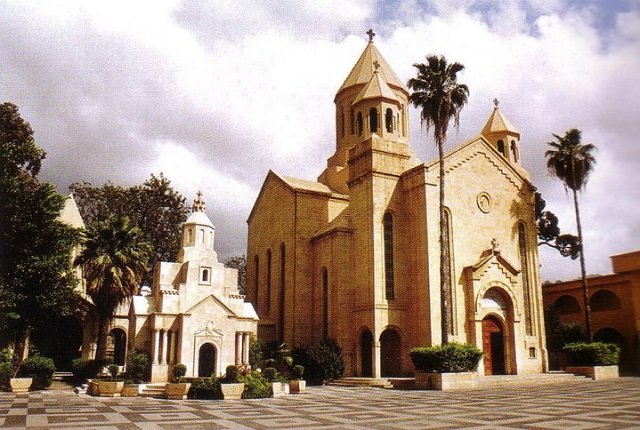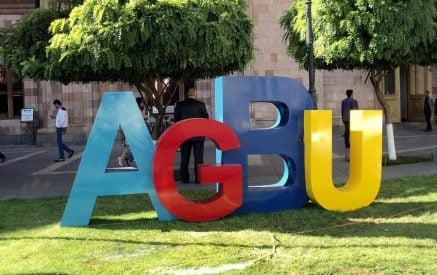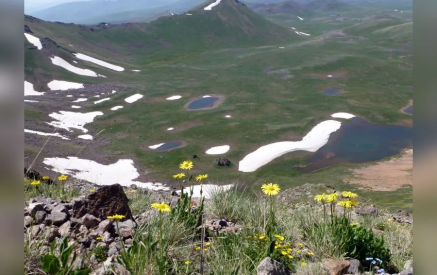The Armenian Weekly We live in a dangerous world. Most Americans are insulated from the violence and deprivation on this planet, but as Armenians we have a unique perspective. As children of the diaspora, our network reaches to every corner of this earth. Many of us were born here and others have migrated here, but all of us have a connection to Armenians somewhere else. When there is strife in places like Lebanon, some of us worry about family, or perhaps mourn for a location that holds a special place in our heart. The diaspora is a convenient term to describe those who represent the dispersed state of the Armenian nation. It is usually the result of forced expulsion or the need for economic betterment. The Armenian Diaspora gained its identity in the early part of the 20th century with the Genocide survivor generation.
Despite our common bond, each community in the diaspora has adapted to certain unique cultural norms from their host nation. Some of these countries have a societal structure that has encouraged Armenian identity. For example, in the Middle East the schools were for the most part run by the Armenian community, thus greatly reducing the risk of assimilation. In contrast, Armenians in America generally live a dual identity as geographic and cultural diversity is more diluted. Each community whether in the Middle East, Europe, the Americas or Australia has adapted in a unique way to retain an identity and function as responsible members of the greater community.
Parts of the diaspora are in a constant state of change due to instability, conflicts and economics. One of the products of the diaspora is the current state of the Great House of Cilicia. It is truly a remarkable story that all Armenians should value. Due to political strife in the Armenian Highlands from foreign invasions, the seat of the Catholicos of All Armenians moved several times through the centuries. In the 11th century it moved to lesser Armenia (Sepastia) for a short time before settling in the Cilicia region during the Armenian kingdom of Cilicia. It remained there for several centuries until 1441. The political environment in Etchmiadzin (eastern Armenia) was stable enough for the Catholicos to return after several centuries. During that time Armenia was split between the Persians in the east and the emergence of the Ottoman Empire in the west. The elder Catholicos decided to stay in Sis, Cilicia; a new Catholicos was elected in Etchmiadzin. Since 1441, we have had two Catholicos, with spiritual authority residing in Etchmiadzin and practical jurisdictional responsibilities established. All hierarchical Sees (Constantinople, Jerusalem and Cilicia) recognize the supremacy spiritually of Holy Etchmiadzin.
The Holy See of Cilicia continued to thrive as a spiritual center in Sis until the Genocide. The cathedral and monastic complex of St. Sophia was destroyed by the Turks during the period of 1915 to 1916. The sitting Catholicos Sahag II was forced into exile and traveled to refugee camps to tend to his ravaged flock. Aside from a brief return in 1918 when the French encouraged the Armenians to return, the See operated without a permanent home until 1930. A permanent home was re-established on the former property of the Near East Relief and quickly expanded to include a seminary, library, publication houses and cathedral. The venerable Catholicos continued to travel to refugee camps assisting his flock in Syria, Lebanon and elsewhere as the Armenians began to rebuild their lives. Jurisdiction was primarily in the Middle East (essentially former Ottoman territories) including Cyprus, Greece and Iran. In 1956, based on the request of American Armenians from the “unaffiliated” parishes, what is now known as the Prelacy was created. Separate Prelacy dioceses were later formed in the western sector of the United States and eventually in Canada.
Read also
Each of our hierarchical Sees today are faced with unique challenges that impact their long term survival. The Constantinople Patriarch is faced with an oppressive Turkish government that denies access to Armenian properties in western Armenia and continues to meddle in the affairs of the church. The seminary has been closed for decades, yet the Turkish government continues to narrow the definition of those eligible for candidacy as Patriarch (as perfectly illustrated in the recent election). The Jerusalem Patriarchate faces the challenge of a dwindling local Armenian population and financial concerns that are further complicated by an unfavorable political environment. Holy Etchmiadzin has been challenged by the unprecedented responsibility of having access to the world diaspora and addressing the overwhelming needs of the Armenians in Armenia. Credibility issues have further challenged the ability of the Holy See to serve the needs of the people.
The See of Cilicia operates in a volatile region that has been subjected to sectarian strife for centuries. In the post-colonial period, most of the nations have had unstable governments and local conflicts have required skillful neutrality by the Armenians. One by one, we have witnessed the marginalizing of the Armenian communities established essentially from the Genocide. The strong Lebanese Armenian community, protector of Antelias and center of diaspora vibrancy, has been reduced to one-third of its size with civil war, sectarian violence and economic problems. The Iraq community has been decimated by the wars in the last decades. Cyprus has been subjected to a partition with the invasion of the Turks. The most recent impact has been the stoic and remarkable community of Syria. Aleppo, the original refugee diaspora after the Genocide and a vibrant Armenian center for decades, has been reduced to a fraction of its population due to the brutality of the civil war. There are many other Armenian populated villages and towns in the north of Syria and elsewhere that have been heavily impacted by the assault on Christian communities. While this demographic shift has been significant, new communities have been established over the years in the Persian Gulf states. It is a difficult position for the Holy See.
How can you encourage emigration from these hot spots that would weaken infrastructure and the adherent base of the See? But the trend is clear. The Armenian communities of the Middle East have been under siege, and their strength has been reduced. Will this continue? If there is a relationship between our demographics and the stability of the region, one would have to surmise that we have not reached the bottom. If the future further reduces the population of the region, and the Antelias See and its infrastructure are reduced to below a critical mass, what will happen to the Holy See? Many Armenians without a relationship with Antelias view it in an adversarial manner with Etchmiadzin. Obviously, this is influenced by the presence of two dioceses in the United States. But the Holy See is much more than a participant in a division. We are all a party to that stain. Many are just beginning to discover this as our knowledge evolves.
In a more natural state, where there is jurisdictional harmony within the church (I avoided the word “split”), we would actually have the ability to discuss these issues from a strategic and rational standpoint. Addressing problems when they become a crisis is the wrong time to expect an optimal solution. Again, in a more natural state where our leaders act like leaders without regard for turf and power but with an eye towards our 10 million strong nation, we might discover a creative solution. In modern times, the See of Cilicia has become the most proficient resource we have in managing the diaspora. I have always viewed the Cilician See as an institution of the diaspora. We should treasure our collective assets and align them in the most effective manner. As we are learning with the current Etchmiadzin administration, meeting the needs of those in Armenia and the diaspora is not “one size fits all.” We are learning this from the perspective of what is not working. The Cilician See has prospered because it has found a way to work productively in diverse cultures where Armenians reside.
One may suggest that the same is true with Holy Etchmiadzin with its administration of Europe, South America and Russia. Until relatively recently, however, they operated as decentralized dioceses while Armenia was under Soviet control and in the first decades of Armenia’s independence. Etchmiadizin’s ability to directly manage a complex diaspora has never been fully tested. The Mother See will clearly benefit with some assistance. Directing the dioceses with an overly centralized loyalty network will not endear the new generation that are part of a dual identity in the diaspora. Another issue is that of eastern versus western Armenian—not simply the dialect, but the identity and cultural norms. Acknowledging the emigration from Baku and Armenia, the western diaspora (US, Canada, South America and Europe) is still predominantly Western Armenian. Is it possible that the See of Cilicia can offer additional relationship value with their superb record of highly trained celibate clergy and experience? Again we need to think about this in the context of a more natural state, not the vision-lacking, highly competitive and overly centralized view of today.
What is apparent is that this has value only when we view the See of Cilicia as a jewel of the full Armenian nation. Our partisan views only limit our potential. Solutions to long term problems start with dialogue today. There is no imminent danger of the See losing its position today, but leaders have the responsibility to act before the crisis is reality. This cannot be the typical silo discussion where each faction addresses its own agenda. It can be a manifestation of our pan-Armenian identity. There is plenty of work here in the business of salvation and ethnic identity for all hierarchical Sees. We don’t live in a static world, but rather a dynamic one. Our thinking must be dynamic to complement that certainty. Let’s all work to tear down old and outdated stereotypes and allow our full capabilities to ensure our future.



























































